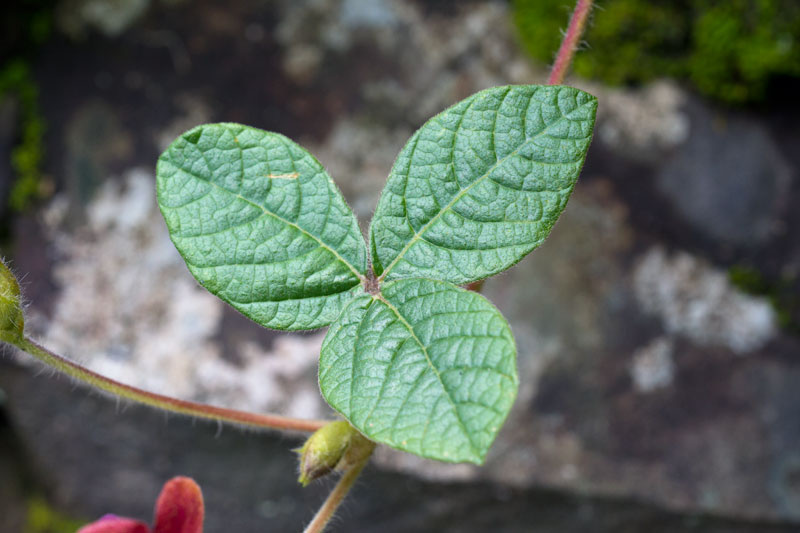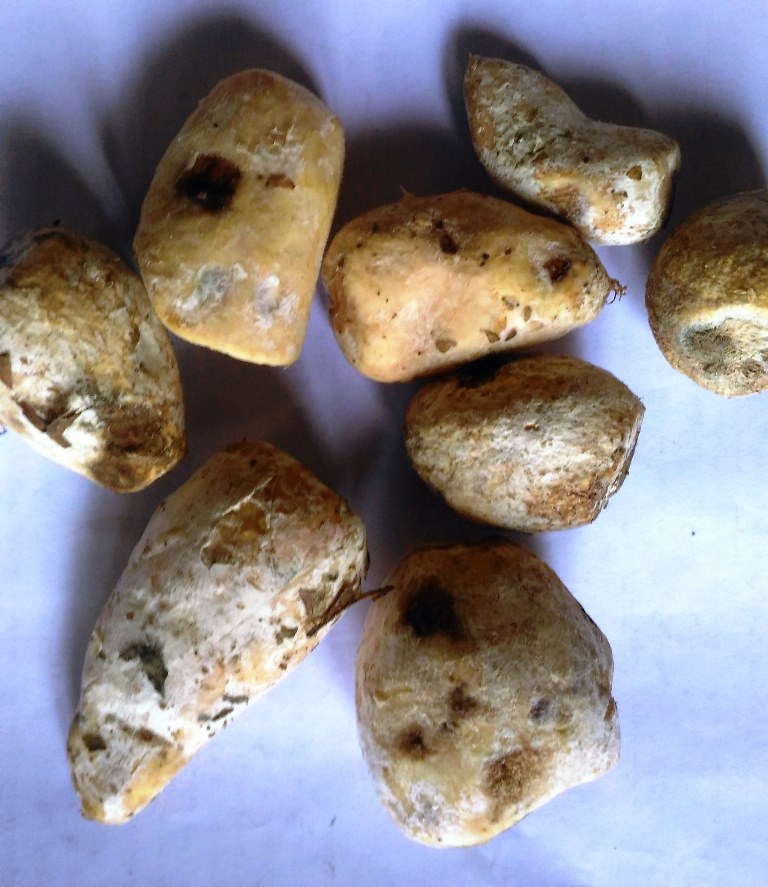|
Flemingia procumbens Roxb. (Syn: Flemingia vestita Baker; Moghania procumbens (Roxb.) Mukerjee; Moghania vestita (Baker) Kuntze);
.
Flemingia vestita (synonyms Flemingia procumbens Roxb.; Moghania vestita (Benth.) ex Baker Kuntze; Moghania procumbens (Roxb.) Mukerjee) famously known as Sohphlang is a nitrogen fixing herb with characteristic tuberous root, belonging to the genus Flemingia. The root is edible and is a common vegetable in some Asian tribal communities. In addition, it has been traditionally used as an anthelmintic, the basis of which is scientifically validated. It is found as a wild herb along the mountain slopes of Himalayas. It is distributed in Sichuan and Yunnan provinces of China, Nepal and Khasi hills , Jaintia Hills of Meghalaya in Northeast India. It is also sparsely found in Laos, Philippines and Vietnam.[1][2]
F. vestita is a perennial herb, having a prostrate but weak stem, measuring about ~60 cm in average. It is highly branched with hairy rhizome and hirsute stems. The roots are tuberous (6 cm or longer). Leaves are pinnately compound with obovate-cuneate leaflets. Leaves are digitately 3-foliolate; and also pubescent like the stem. Lateral leaflets are obliquely elliptic, and slightly smaller. Raceme is axillary or terminal, about 2-10 cm, and densely pubescent; bracts lanceolate. Calyx is 5-lobed; lobes are linear-lanceolate, lower one is longest, longer than the tube. Corolla is slightly longer than calyx and elliptical. Fruits are hairy sub-cylindrical pods. Seed is globose, brown or black in colour. Flowers are bright-red. It flowers during August and September.[3][4]
The juicy tuber is a highly priced vegetable among the Garo , Khasi and Jaintia tribes of Meghalaya, India. In fact its demand as foodstuff has increased so much that it has been cultivated as a cash crop and is regularly available in the local markets.[1] The delicate skin is easily peeled off to expose a smooth cream-coloured flesh that has a sweet, nut-like flavour. In terms of nutritional value, it is particularly rich in phosphorus and proteins.
The tuber has been an indigenous vermifuge among the Khasis, to whom it is called soh-phlang. The raw tuber or the root peel is directly consumed for the treatment of soft-bodied intestinal worms.[6] Experimental investigation started in 1996 when the in vitro activity of tuber peel extract was tested against different helminth parasites, including the nematodes such as Ascaris suum, Ascaris lumbricoides, Ascaridia galli, Heterakis gallinarum, a cestode Raillietina echinobothrida and trematodes such as Paramphistomum sp.,[7] Artyfechinostomum sufrartyfex and Fasciolopsis buski.[8] In 1991 an isoflavone, genistein was isolated from the tuber extract[5] which was demonstrated to be the major anthelmintic principle, highly potent against trematodes and cestodes. It was further demonstrated effective against the sheep liver fluke Fasciola hepatica[9] and human tapeworms such as Echinococcus multilocularis and E. granulosus metacestodes.[10]
Its property of nitrogen fixation has been put to experimental use. Mixed cropping with F. vestita was found to give better economic returns, mainly due to improved soil fertility with a net gain in nitrogen of up to 250 kg/ha/year.[11]
(From Wikipedia on 20.11.14)
. Legume for ID_Oct.2014_DSR_8 : 10 posts by 4 authors. Attachments (1)
This legume was shot in Kali Valley, Pithoragarh District (Uttarakhand) on a grassy slope at an altitude of 2200m in July 2013. Please suggest the ID. It seems Centrosema pubescens Id still awaited by me too, recorded from many places in Western Himalayas.. Centrosema are american taxa naturalized in some areas of South India. These are not known in North India or Himalaya.
Could it be a species of Rhynchosia; it resembles partially to R.rothi. efi page on Rhynchosia rothii We should stick to Rhynchosia rothii as the leaflets are digitately trifoliate, whereas it is pinnatly trifoliate in Centrosema This is probably a tentative id.. I have seen one more such plant, from plains in Haryana, also identified as Rhynchosia rothii… but is certainly distinct in bearing longer racemes and creamy petals with purple patches.. I will post it for comparison.. Yes …, it should be tentative. R.rothi is a relatively lower altitude species. We have 7 species of Rhynchosia in Uttarakhand- R.capitata, R.falconeri, R. himalensis, R. minima, R. pseudo-cajan, R.rothi and R. tomentosa. It is Flemingia procumbens. Tubers are edible and taste resembles to Pureria tuberosa and eaten by the local people. Fabaceae (Faboideae) Fortnight :: Legume for id:: Gori Valley & Chakrata :: NS OCT 134/134 : 8 posts by 4 authors. Attachments (5)
Please suggest id for this legume, which was recorded from Chakrata, as well as Gori valley… I believe this is a species of Desmodium It must be Femingia vestita Thanks, … It seems to match with photos of … of Flemingia procumbens (Syn: Flemingia vestita Baker)
Flemingia procumbens from Shimla. Attachments (1) Fabaceae (Faboideae) Fortnight: Rhynchosia rothii from Mussoorie Chakrata Road-GSOCT62/67 : 1 post by 1 author. Attachments (3)
Rhynchosia rothii Benth. ex :Aitch., Cat.Pl.Punj.Sind. 50. 1869. syn: Rhynchosia sericea Spanoghe; Dolichos tomentosus Roth
Twining woody plant with glandular hairy stems, trifoliate leaves with rhomboid to suborbicular leaflets, pubescent on both sides; flowers dark red, 2 cm long, on axillary peduncled raceme; pod up to 4 cm long, 2-seeded.
Photographed from Mussoorie Chakrata road in September. Flemingia procumbens as per images herein. .
Rhynchosia rothii Benth. ex :Aitch., Cat.Pl.Punj.Sind. 50. 1869.
syn: Rhynchosia sericea Spanoghe; Dolichos tomentosus Roth
Twining woody plant with glandular hairy stems, trifoliate leaves with rhomboid to suborbicular leaflets, pubescent on both sides; flowers dark red, 2 cm long, on axillary peduncled raceme; pod up to 4 cm long, 2-seeded.
Photographed from Mussoorie Chakrata road in September. Good Shot sir here are mines
pls validate This reminds me about my Rhynchosia….not posted yet Flemingia procumbens as per images herein.
Found this early into my walk yesterday at about 1900m. I am not sure of its identity. Please help.
Above Mcleodganj, Dharamshala, HP
1900m
21 August 2016. Wonderful captures …, This is Rhynchosia sp. Thank you very much … According to our group site here it is R. rothii which is a synonym of R. sericea (the only Rhynchosia species with red flowers according to Col Collett). I am sorry for hurrying into id.. This has been identified as Flemingia procumbens…!! Thank you … To me the earlier ID at the eflora site looks identical. Is there a mistake here? Thanks, … It’s Flemingia procumbens only.
I have corrected the images now at Rhynchosia rothii
Flemingia procumbens Roxb. : 2 posts by 2 authors. Attachments (1)
Bright white fresh tubers of Flemingia procumbens Roxb. is sold in the shillong market, which is consumed as a salad. Flemingia procumbens Roxb. : 3 posts by 1 author. Attachments (5)- around 1100 kb each.
Location: Champadevi, Kathmandu, Nepal
Altitude: 2105m.
Date: 02 September 2019
Habit : Wild
Attachments (2)- 2 & 3 mb.
Attachments (1)- 6 mb.
.
Rhynchosia rothii from Uttarakhand-GS17122021-9: 4 images.
Rhynchosia rothii clicked from along Mussoorie Chakrata Road near Baratkhai, Uttarakhand, from Uttarakhand, 16-9-2011. I think Flemingia procumbens, as per images and details herein. Looks different from images at Rhynchosia rothii
You are absolutely right … |










